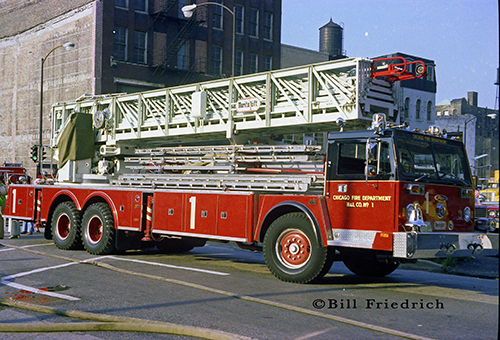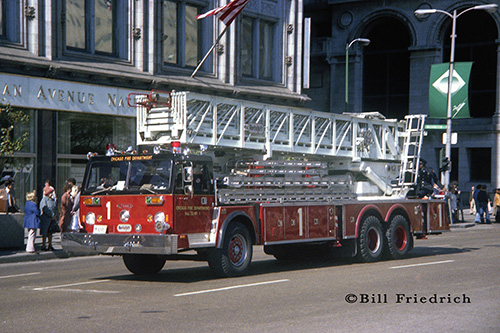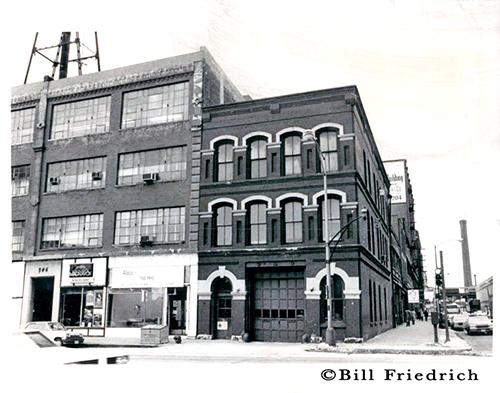This from Bill Friedrich on the one-of-a-kind 135′ Hendrickson/Pierce/Morita ladder in Chicago
Here is a shot of Truck 2’s old house at 540 W. Washington Blvd. Truck 2 was scheduled to get the new Hendrickson/Pierce/Morita that did not fit. I am also attaching photos of (EF-197), the 1974 Hendrickson – Pierce – Morita Aerial Lift (Pierce # 8276-C). You have a good view of the aerial itself as well as the ground ladder storage. I am also sending a parade photo showing where the ff’s rode on the back step.When they realized the height of the ladder would not fit the doors, they exchanged rigs with Truck 1 (EF-192), a 1972 Alfco 1000 Series Ladder Chief.I am trying to locate a shot of the company showing Hook & Ladder 2.Bill

Chicago Truck 1 (EF-197), a 1974 Hendrickson 1871/Pierce/Morita 135’Ladder. BIll Friedrich photo

Chicago Truck 1 (EF-197), a 1974 Hendrickson 1871/Pierce/Morita Ladder. BIll Friedrich photo

Truck 2’s house at 540 W. Washington Boulevard. Bill Friedrich photo



















































#1 by Bill Post on May 5, 2013 - 6:38 PM
Grumpy Grizzly the Mack C cab 146-footers didn’t last very long as high ladder companies either. Ladder 13’s rig became High Ladder 1 on February 3, 1964 and it was shifted around several times until it was taken out of service on April 22nd of 1966. High Ladder 2 went in service on April 24, 1965 and was taken out of service on August 14, 1965. It’s rig was then given to Ladder 119 in Brooklyn as they were located with the new Super Pumper, which was later relocated to the house on Tillary Street in 1972.
Because the Magirus ladders were difficult to maintain, in 1969 the FDNY removed the 146′ ladders from the Mack C cab chassis and retrofitted them with 100-foot Grove ladders.
The main difference is that Chicago continued using the Magirus 144-footers until the apparatus were taken out of service and retired in the mid 70’s. In essence, Chicago continued using tall ladders. When the 144-foot Magirus ladder in the loop was replaced by the 135-foot Morita-lift aerial ladder, and then that was replaced by 135-foot Emergency One aerial ladders in the 80’s at Truck’s 3 and 1.
#2 by Bill Post on May 5, 2013 - 1:21 AM
Den the Hendrickson Morita “lift” 135 foot Ladder that you are talking about was the only Morita fire apparatus that Chicago had used.
#3 by Grumpy grizzly on May 4, 2013 - 2:23 PM
Back in 1961 FDNY received its first rear mounts, they were 146′ 7 section Magirus ladders on Mack “C” chassis. Were iriginally assigned to Ladder companies 13 and 24 but were redesnated as special units as High Ladder Units 1 and 2
#4 by Den on May 4, 2013 - 3:08 AM
Morita this a japanese brand? Aside from morita 135′ ladder did the CFD continue to use morita product?
#5 by Eric on March 14, 2013 - 12:20 PM
Somewhat related: I’ve been through the Little & McNalis books and there’s no reference to E-156. Anybody have information on that one?
#6 by Dennis on March 13, 2013 - 4:55 PM
Bill, the 1960 Mack/Magirus 144′ RM that was assigned to Truck 39 was shop# EF-153. After Truck 39 it was reassigned to Truck 3. Then finally toTruck 2. The first Mack/Magirus assigned to Truck 3 was a 100′ RM (EF-151). Then they got EF-152 which was a 144′ RM. They kept that rig till 1969 when they got their third Mack/Magirus which was EF-153.
#7 by Mike on March 13, 2013 - 1:03 PM
E-One has their 137 foot ladder in production now so there could b a possibility of aerial tower 1 getting their big ladder back.
#8 by Bill Post on March 13, 2013 - 1:58 AM
Speaking of 135-foot aerial ladders, Chicago was one of a handful of fire departments that had been using “High” ladders or “High “Aerial Devices. For the sake of defining the term I would define “high” as any Ladder or device that is over 110 feet in height as most standard aerial devices tend to be less than that.
The Chicago Fire Department had been using “High” Aerial Ladders since 1960 when they purchased two 144-foot rear-mounted Magirus Aerial Ladders built on Mack B-Series chassis. The two aerial ladders were originally assigned to Truck 39 when they were located at 25 S. Laflin (currently Engine 103’s quarters) and Truck 3 when they were at 158 W. Erie, and for a little over a year at Truck 3’s current quarters at 55 W. Illinois. The rigs were eventually reassigned to Truck 8 at it’s current quarters and Truck 2 when they were at 540 W Washington. Both rigs were out of service by mid 1976.
History aside, the Chicago Fire Department had been using “High” Aerial Ladders for about 46 years from 1960 through mid 2006 when our last 135-foot E-One aerial ladder was taken out of service at Truck (Aerial Tower 1) and replaced by the current 105-foot Pierce heavy-duty aerial ladder.
Therefore I would like to make a suggestion. The Chicago Fire Department should seriously consider purchasing either a Spartan ERV Telstar articulating telescopic platform which is 132-feet when fully extended or purchase a 134-foot Bronto Skylift articulating aerial platform on a Pierce chassis. It could probably be assigned to Aerial Tower (Truck 1) and/or Truck 3, which is where Chicago’s last two 135-foot aerial Ladders were assigned. Both of these articulating model telescoping platforms are in effect large Snorkels and are safer then a conventional 135-foot aerial ladder as they feature enclosed baskets to work from, and also in effect could replace our 1982 Seagrave/Pierce reserve Snorkel.
While the tallest Bronto Skylift that is built overseas is 367-feet tall, the largest one that is built for the US market licensed through Pierce Manufacturing is 134-feet tall. The one built by Spartan Erv is designed by a French called GIMAEX, which builds fire apparatus overseas as well.
Emergency One is once again marketing a 137-foot straight aerial ladder, and Smeal builds a 125-foot straight aerial ladder, but why get a straight ladder when you can get a platform with a built-in turret?
First however, the CFD needs to order new tower ladders and keep it’s conventional fleet up to date, but it really should consider one or two 132 to 134 foot aerial platforms for a few years down the road.
#9 by DMc77 on March 6, 2013 - 12:05 AM
I love the little red painted section at the end of the fly. Nothing spells confidence at 135′ elevation more than that…
#10 by Drew Smith on March 5, 2013 - 7:14 PM
Back step or tailboard riding was wide spread and common place until the passage of the original NFPA 1500 standard in 1987. It prohibited riding on the exterior of all apparatus. The LODD stats back then had 25% of the deaths attributed to falls from moving apparatus. This along with the requirement for fully enclosed cabs is credited with the sharp reduction in LODDs in the early 90s. Although I’m sure you will find someone riding the rear some where. Five years ago while on my way home from northern Wisconsin I witnessed some volunteers riding the rear step of a pumper in a town that sits on Lake Michigan’s shore.
#11 by Mike McAuliffe on March 5, 2013 - 4:34 PM
Keep in mind the era. Riding on the back step was still a common practice in 1974. Even on the rigs that had jump seats, most of the firemen would ride the back step. The ones that did use the jump seats would stand up, face forward, and hold onto the rail. It was somewhat rare to see them actually seated in the jump seat. Even so, they may have been safer than the 7th member of the company that rode in the “phone booth” on FDNY Seagrave rearmounts around the same time frame.
I will admit that the CFD did compromise safety on one group of trucks, the four 1976 Seagrave tillers. Instead of purchasing cabs from Seagrave, they used Internationals with no jump seats. The firemen had to hang onto the side of the truck using the ground ladders for grips. Also, no enclosure whatsover for the tillerman. The same set up as tillers purchased in the early 1950’s. No progress in 20 plus years with regard to safety. Even for Robert J. Quinn, that was pretty sad.
Cambridge MA did the same thing with Seagrave tillers, but I’m pretty sure they enclosed the tillerman.
#12 by John H on March 5, 2013 - 2:03 PM
It really is amazing how times have changed re: fire-fighter safety. With this Morita truck, clearly firefighter safety was complete afterthought…”we built this great ladder truck, but there really wasn’t room for the firefighters when all was said and done…so they can just hang onto the back of the truck.”
#13 by Chuck on March 4, 2013 - 6:28 PM
Bill, wasn’t this the rig that snapped the ladder dogs one day when they made a stop on a downtown street, and the ladder shot straight out off the front of the rig? I seem to remember a chain binder holding the sections in place on the base section of the ladder in the back…..
#14 by Bill Friedrich on March 3, 2013 - 5:32 PM
The Hendrickson – Pierce – Morita was taken out of service due to safety concerns. There was no place for the fire fighters to safely ride on the rig. It was eventually cut up for scrap.
#15 by grumpy grizzly on March 3, 2013 - 10:02 AM
If you have a copy of Walter McCall’s book American Fire Engines since 1900 there is a picture of this rig numbered as Truck 2. It is on page 373 and the photo was taken by Dan Martin.
#16 by John on March 3, 2013 - 7:55 AM
How long did it last in service,and what happened to it?